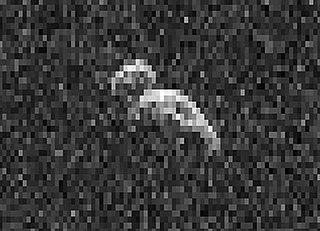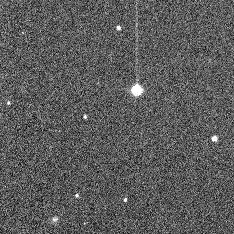Related Research Articles

Interplanetary spaceflight or interplanetary travel is the crewed or uncrewed travel between stars and planets, usually within a single planetary system. In practice, spaceflights of this type are confined to travel between the planets of the Solar System. Uncrewed space probes have flown to all the observed planets in the Solar System as well as to dwarf planets Pluto and Ceres, and several asteroids. Orbiters and landers return more information than fly-by missions. Crewed flights have landed on the Moon and have been planned, from time to time, for Mars, Venus and Mercury. While many scientists appreciate the knowledge value that uncrewed flights provide, the value of crewed missions is more controversial. Science fiction writers propose a number of benefits, including the mining of asteroids, access to solar power, and room for colonization in the event of an Earth catastrophe.

A near-Earth object (NEO) is any small Solar System body orbiting the Sun whose closest approach to the Sun (perihelion) is less than 1.3 times the Earth–Sun distance. This definition applies to the object's orbit around the Sun, rather than its current position, thus an object with such an orbit is considered an NEO even at times when it is far from making a close approach of Earth. If an NEO's orbit crosses the Earth's orbit, and the object is larger than 140 meters (460 ft) across, it is considered a potentially hazardous object (PHO). Most known PHOs and NEOs are asteroids, but about 0.35% are comets.

Asteroid impact avoidance comprises the methods by which near-Earth objects (NEO) on a potential collision course with Earth could be diverted away, preventing destructive impact events. An impact by a sufficiently large asteroid or other NEOs would cause, depending on its impact location, massive tsunamis or multiple firestorms, and an impact winter caused by the sunlight-blocking effect of large quantities of pulverized rock dust and other debris placed into the stratosphere. A collision 66 million years ago between the Earth and an object approximately 10 kilometres wide is thought to have produced the Chicxulub crater and triggered the Cretaceous–Paleogene extinction event that is understood by the scientific community to have caused the extinction of all non-avian dinosaurs.

The term Spaceguard loosely refers to a number of efforts to discover, catalogue, and study near-Earth objects (NEO), especially those that may impact Earth.

The B612 Foundation is a private nonprofit foundation headquartered in Mill Valley, California, United States, dedicated to planetary science and planetary defense against asteroids and other near-Earth object (NEO) impacts. It is led mainly by scientists, former astronauts and engineers from the Institute for Advanced Study, Southwest Research Institute, Stanford University, NASA and the space industry.

The Discovery Program is a series of Solar System exploration missions funded by the U.S. National Aeronautics and Space Administration (NASA) through its Planetary Missions Program Office. The cost of each mission is capped at a lower level than missions from NASA's New Frontiers or Flagship Programs. As a result, Discovery missions tend to be more focused on a specific scientific goal rather than serving a general purpose.
99942 Apophis (provisional designation 2004 MN4) is a near-Earth asteroid and a potentially hazardous object with a diameter of 370 metres (1,210 feet) that caused a brief period of concern in December 2004 when initial observations indicated a probability up to 2.7% that it would hit Earth on April 13, 2029. Additional observations provided improved predictions that eliminated the possibility of an impact on Earth in 2029. Until 2006, a small possibility nevertheless remained that, during its 2029 close encounter with Earth, Apophis would pass through a gravitational keyhole of no more than about 800 kilometres (500 mi) in diameter, which would have set up a future impact exactly seven years later on April 13, 2036. This possibility kept it at Level 1 on the Torino impact hazard scale until August 2006, when the probability that Apophis would pass through the keyhole was determined to be very small and Apophis's rating on the Torino scale was lowered to zero. By 2008, the keyhole had been determined to be less than 1 km wide. During the short time when it had been of greatest concern, Apophis set the record for highest rating ever on the Torino scale, reaching level 4 on December 27, 2004.

A sample-return mission is a spacecraft mission to collect and return samples from an extraterrestrial location to Earth for analysis. Sample-return missions may bring back merely atoms and molecules or a deposit of complex compounds such as loose material and rocks. These samples may be obtained in a number of ways, such as soil and rock excavation or a collector array used for capturing particles of solar wind or cometary debris. Nonetheless, concerns have been raised that the return of such samples to planet Earth may endanger Earth itself.

65803 Didymos is a sub-kilometer asteroid and binary system that is classified as a potentially hazardous asteroid and near-Earth object of the Apollo group. The asteroid was discovered in 1996 by the Spacewatch survey at Kitt Peak, and its small 160-meter minor-planet moon, named Dimorphos, was discovered in 2003. Due to its binary nature, the asteroid was then named Didymos, the Greek word for 'twin'.

OSIRIS-REx was a NASA asteroid-study and sample-return mission that visited and collected samples from 101955 Bennu, a carbonaceous near-Earth asteroid. The material, returned in September 2023, is expected to enable scientists to learn more about the formation and evolution of the Solar System, its initial stages of planet formation, and the source of organic compounds that led to the formation of life on Earth. Following the completion of the primary OSIRIS-REx mission, the spacecraft is planned to conduct a flyby of asteroid 99942 Apophis, now as OSIRIS-APEX.

NEO Surveyor, formerly called Near-Earth Object Camera (NEOCam), then NEO Surveillance Mission, is a planned space-based infrared telescope designed to survey the Solar System for potentially hazardous asteroids.
The Asteroid Impact and Deflection Assessment (AIDA) missions are a proposed pair of space probes which will study and demonstrate the kinetic effects of crashing an impactor spacecraft into an asteroid moon. The mission is intended to test and validate impact models of whether a spacecraft could successfully deflect an asteroid on a collision course with Earth.

The Asteroid Redirect Mission (ARM), also known as the Asteroid Retrieval and Utilization (ARU) mission and the Asteroid Initiative, was a space mission proposed by NASA in 2013; the mission was later cancelled. The Asteroid Retrieval Robotic Mission (ARRM) spacecraft would rendezvous with a large near-Earth asteroid and use robotic arms with anchoring grippers to retrieve a 4-meter boulder from the asteroid.

The Planetary Defense Coordination Office (PDCO) is a planetary defense organization established in January 2016 within NASA's Planetary Science Division of the Science Mission Directorate.
Asteroid laser ablation is a proposed method for deflecting asteroids, involving the use of a laser array to alter the orbit of an asteroid. Laser ablation works by heating up a substance enough to allow gaseous material to eject, either through sublimation or vaporization. For most asteroids this process occurs between temperatures in the range of 2,700–3,000 K. The ejecting material creates a thrust, which over an extended period of time can change the trajectory of the asteroid. As a proof of concept on a small scale, Travis Brashears, a researcher at UC Santa Barbara's Experimental Cosmology Lab, led by Dr. Philip Lubin, has already experimentally verified that laser ablation can de-spin and spin-up an asteroid.

A Hypervelocity Asteroid Intercept Vehicle (HAIV) is a spacecraft being developed by NASA to deflect dangerous Near Earth objects (NEOs) such as comets and asteroids that threaten colliding with Earth. The vehicle is intended to use powerful explosives, such as nuclear bombs, to deflect the NEO by detonating on the surface, thus changing its trajectory to miss Earth. This method of asteroid impact avoidance is intended to be used on dangerous NEOs detected within a short time frame (less than 5 years) before a possible impact event with Earth. The idea came about when asteroid detection improved. Since then, scientists and engineers have sketched a design for an HAIV.

Double Asteroid Redirection Test (DART) was a NASA space mission aimed at testing a method of planetary defense against near-Earth objects (NEOs). It was designed to assess how much a spacecraft impact deflects an asteroid through its transfer of momentum when hitting the asteroid head-on. The selected target asteroid, Dimorphos, is a minor-planet moon of the asteroid Didymos; neither asteroid poses an impact threat to Earth, but their joint characteristics made them an ideal benchmarking target. Launched on 24 November 2021, the DART spacecraft successfully collided with Dimorphos on 26 September 2022 at 23:14 UTC about 11 million kilometers from Earth. The collision shortened Dimorphos' orbit by 32 minutes, greatly in excess of the pre-defined success threshold of 73 seconds. DART's success in deflecting Dimorphos was due to the momentum transfer associated with the recoil of the ejected debris, which was substantially larger than that caused by the impact itself.

Dimorphos is a natural satellite or moon of the near-Earth asteroid 65803 Didymos, with which it forms a binary system. The moon was discovered on 20 November 2003 by Petr Pravec in collaboration with other astronomers worldwide. Dimorphos has a diameter of 177 meters (581 ft) across its longest extent and it was the target of the Double Asteroid Redirection Test (DART), a NASA space mission that deliberately collided a spacecraft with the moon on 26 September 2022 to alter its orbit around Didymos. Before the impact by DART, Dimorphos had a shape of an oblate spheroid with a surface covered in boulders but virtually no craters. The moon is thought to have formed when Didymos shed its mass due to its rapid rotation, which formed an orbiting ring of debris that conglomerated into a low-density rubble pile that became Dimorphos today.

Hera is a space mission in development at the European Space Agency in its Space Safety program. Its primary objective is to study the Didymos binary asteroid system that was impacted by DART and contribute to validation of the kinetic impact method to deviate a near-Earth asteroid in a colliding trajectory with Earth. It will measure the size and the morphology of the crater created by and momentum transferred by an artificial projectile impacting an asteroid, which will allow measuring the efficiency of the deflection produced by the impact. It will also analyze the expanding debris cloud caused by the impact.
References
- ↑ Khartoum, Sarah (15 March 2018). "Nasa draws up plans for huge spacecraft to blow up doomsday asteroid". The Telegraph . Retrieved 17 March 2018.
- ↑ Vergano, Dan (7 March 2018). "Government Scientists Have A Plan For Blowing Up Asteroids With A Nuke". BuzzFeed . Retrieved 17 March 2018.
- ↑ Parsons, Jeff (16 March 2018). "NASA building 'HAMMER' spacecraft to save Earth from cataclysmic asteroid impact". Mirror . Retrieved 17 March 2018.
- ↑ Whitwam, Ryan (9 March 2018). "NASA Designs HAMMER Spacecraft to Deflect or Nuke Dangerous Asteroids". ExtremeTech . Retrieved 18 March 2018.
- ↑ Vergano, Dan (7 March 2018). "Government Scientists Have A Plan For Blowing Up Asteroids With A Nuke". BuzzFeed . Retrieved 18 March 2018.
- ↑ "NASA May Build 'HAMMER' Spacecraft To Blow Up Earth-Bound Asteroid". NDTV . 16 March 2018. Retrieved 18 March 2018.
- ↑ Barbee, Brent W.; Syal, Megan Bruck; Dearborn, David; Gisler, Galen; Greenaugh, Kevin; Howley, Kirsten M.; Leung, Ron; Lyzhoft, Josh; Miller, Paul L.; Nuth, Joseph A.; Plesko, Catherine; Seery, Bernard D.; Wasem, Joseph; Weaver, Robert P.; Zebenay, Melak (2018). "Options and uncertainties in planetary defense: Mission planning and vehicle design for flexible response". Acta Astronautica. 143: 37–61. Bibcode:2018AcAau.143...37B. doi: 10.1016/j.actaastro.2017.10.021 .



